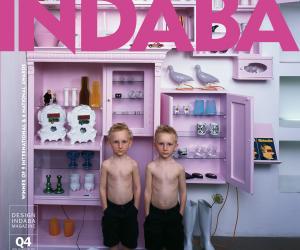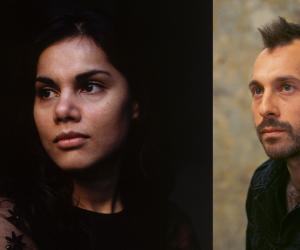First Published in
The partnership between furniture designer Nipa Doshi and industrial designer Jonathan Levien has distinguished itself for marrying utilitarian sensibility and sensual delight. Having established their design company, DoshiLevien, in 2000, “the ride has turned into a flight recently”, exclaims Levien. This is a fair assessment considering the mob that their collection of Indian daybeds, Charpoy, attracted at this year’s Milan Furniture Fair. Catch them at Design Indaba 2008.
Design Indaba (DI): Nipa is consistently described as being inspired by the street culture of India, how British and Indian cultures meet, and a fascination with textiles. Jonathan is described as having more European influences, with a background in cabinet making and industrial design. Are these roles always so clearly demarcated?
Nipa Doshi (ND): I don't think the roles are demarcated. When you are in a partnership people always pester you about who does what and of course there are strengths that I have and strengths that Jonathan has. But the outcome of the work is us working together and that’s what makes it interesting. Of course, I’m inspired by the street culture of India for example, but I am equally inspired by very utilitarian stationery made in Germany, or graphics, for example.
Jonathan Levien (JL): I would say that the approach I bring to the partnership is very Germanic. Nipa’s approach is more often than not celebratory and seeks to express meaning and narrative through what she does.
ND: Yes, if you were going to make any distinctions, it’s more in how we approach things rather than in what we are inspired by. Jonathan was trained in industrial design and has a rigour in terms of how he finishes projects and thinks about an idea, which is very different from mine. It’s a combination of the rational and sensual.
JL: Patrizia Moroso described our approach quite nicely when she said that we allow each other to contaminate each other’s approach. I quite like that because it acknowledges that we both have very distinct, separate approaches to design and that we maintain those, but at the same time we are willing to let the other person “contaminate”, play with and challenge our approaches.
ND: Also, when you are in a partnership, the reason for a partnership is that at some level you also need the other person. It is the coming together that makes it complete.
JL: So the result is that a product or project is about neither one nor the other person, but more like a “one and one makes three” scenario.
DI: In the same way that “one and one makes three”, unlikely combinations emerge in your designs – for instance, “local values and universal appeal” and “utilitarian sensuality”.
JL: These ideas coexist as layers in a project. For us, we like to keep going through a project cultivating these layers until it becomes rich and meaningful. For instance, the utilitarian aspect is one layer, how it relates to the culture in which it is used is another layer and how people relate to it emotionally is still another layer. With Tefal, for example, we created patterns on the bases of the pans that emphasise the cultural relevance of the cookware, as opposed to emphasising the technological aspects. These patterns are one of the layers in the project, but at the same time the project is very much about utility, sensuality and enjoying the feeling of the product in use.
DI: Was it these layers in your Charpoy collection for Moroso that created such a big stir at Milan Furniture Fair this year?
ND: The Charpoys bring together Italian industrial production with very fine Indian craftsmanship and they are also imbued with layers of techniques and references that go beyond culture, appealing to people in a very universal way. There’s a lightness to these objects. At the Milan Furniture Fair, visitors were stroking the pieces and wanted to take them home. They related at a very emotional level to the intensity of the work put in by the craftspeople, the intensity of the idea, the fabulous execution and the context. As Patrizia Moroso said, “If there is love in the work, it comes through in the product. If the intent is there, then it shows.”
JL: What we’re quite keen to do with our partnership is expand the references of the design world, which tends to be very Eurocentric. There are a lot of influences from different parts of the world that can be inculcated into our European approach to design. Charpoy shows a very different visual language coming from a very different culture, within the context of a European design show, which is probably what people found refreshing.
DI: You reportedly have strong ideas about how India can express itself without resorting to ethnic clichés. This is also a relevant issue in Africa, particularly with the seeming worldwide trend towards “new craft” and more handmade goods.
ND: When a country talks about “craft” and “how to market craft”, it has to be very clear about what it can offer and that it’s not perpetuating the clichés about craft and the crafted object. One needs to start with what one is really excellent at and what is unique about it, and then ask how to sell these products, not as cheap tourist souvenirs, but by adding value to the handmade. I always tell people not to go to India for cheap stuff, but for the best in craftsmanship. That it is the way forward for craft.
JL: In terms of design consultancy, the notion of harnessing a country’s cultural capital extends further than just craft and handmade goods, into industrial and mass production. We need to understand the aspirations and needs of other countries as being distinct from Europe’s. If we are going to export our design skills and services, we don’t need to necessarily bundle our cultural values with that.
DI: A lot of designers, besides you, are talking about their work telling stories. Is this a trend, what is your take on it?
ND: You can say it is a trend, but it still depends on what kind of story the designs are telling. For example, the Moroso Charpoys can be enjoyed for their colours and graphic values, but there’s another layer in that all the people who have worked on them have embroidered their names on them. Although those names are written in Hindi script, which means that most European buyers won’t be able to read it, there is still a connection between the person who made it and the person who buys it. This could be a way of telling the story: That the person who made the piece is part of the life of the person who buys it. In turn, if the product allows people to connect with it emotionally on some level, people can also attach their own stories to a product.
JL: Telling stories are another way of engaging people. We have so much stuff and there are so many products and things in our lives. People are seeing telling stories and narratives as a way of reaching out and engaging with people on a level of the imagination that would not otherwise be accessed in the plain utility or function of an object. Jaime Hayon, I think, does that very successfully in his work.
DI: Your window installations for the Wellcome Trust are also a fantastic example of utilising story in design.
ND: Oh, that was completely about combining technology with telling a story, but the magic was in how we told the story. The Wellcome Trust is the world’s biggest medical charity. As part of the opening celebration for their new building, they commissioned us to tell the general public about what they do. The challenge was how to tell the story without showing pictures of science and technology, the inside of the intestines, disease cells and so on. So we created a theatre set and decided to tell the story over intervals of four months, changing the window three times.
JL: The idea was to shift the attention away from biomedicine towards wellbeing as a state of mind as well as a state of the body. Instead of the usual print media seen on Euston Road, we used a very visceral, tactile approach. For instance, the installations were hand painted but using computer-generated imagery for the words. We combined real objects with trompe-l’oeil imagery in a way that was engaging.
ND: For instance, we created a dress called The Healing Dress, which is a paper silk dress with bandages embroidered onto it. It talks about a project funded by the trust whereby living bandages have been developed to heal severely burnt skin. Also, we embroidered the private thoughts of the founder, Henry Wellcome, on the privacy screen that you see in the Wellbeing Centre installation.
JL: In the second installation, we put a curiosity café in one of the 12-metre windows and we had “curiosity funding” painted in the adjacent window – the remit of the Wellcome Trust, as defined by us. In the café we had tables spinning with zoetrope animations by Eduard Muybridge. The trust actually holds the collection of Muybridge animations and this was a way for us to tie together the café with curiosity and the archive of the trust.
ND: The windows were very layered. People said that the installation changed their journey to work because they would constantly look for hidden goodies. There was a sense of discovery and every day they would look to discover something new.
DI: What are you working on at the moment?
ND: We’re just completing four pairs of shoes. This is the result of a very generous award from the Arts Council of England. The project is called Apprentice, which we proposed to them. The idea was to work within the city of London with fifth-generation shoemakers who not only understand your foot, but the materials, bone structure, movement and comfort. Stepping into the world of shoes is like walking through a narrow doorway into a vast area of knowledge. It is a more experimental project – a commercial client probably wouldn’t have come along with a project like this. We have designed four pairs of shoes with John Lobb. This family of bootmakers produce “made to measure” boots and shoes that are “finely tailored to fit each individual foot to perfection” – really bespoke.
























